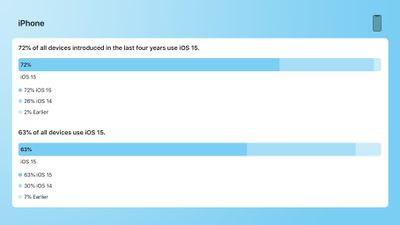Apple today updated its iOS 15 installation numbers for the first time since iOS 15 was released in September, giving us an idea of how many devices are running the latest update four months after it launched.

iOS 15 is installed on 72 percent of all iPhones introduced in the last four years. 26 percent of devices continue to use iOS 14, and two percent run an earlier version of iOS. When counting iPhones released more than four years ago, 63 percent of them run iOS 15, 30 percent run iOS 14, and seven percent run an earlier version of iOS.
Installation numbers are lower on the iPad. 57 percent of all iPads introduced in the last four years are running iPadOS 15, while 39 percent continue to run iPadOS 14. Four percent run an earlier version of iPadOS. Counting all iPads, including those released more than four years ago, 49 percent of devices are running iPadOS 15, 37 percent are running iPadOS 14, and 14 percent are running an earlier version of iPadOS.

Apple splits its installation numbers into separate groups because there are still devices in the wild that are not capable of running iOS 15 or iPadOS 15, but even when counting only devices released in the last four years, the number of devices running iOS 15 lags behind prior operating system installation rates.
iOS 14, for example, was installed on 81 percent of iPhones released in the last four years in December 2020, marking a much higher update rate a month earlier. Even iOS 13, another update that saw slow installation, was installed on 77 percent of devices by the end of January 2020.
iOS 15 and iPadOS 15 had several features that did not arrive as expected when the operating systems launched, such as SharePlay, and Digital Legacy, and other features like iCloud Private Relay remain in beta. People were also put off by Apple's anti-CSAM measures, which have been indefinitely delayed. Key iOS and iPadOS 15 features like digital IDs in Wallet and Universal Control are still unavailable, but could spur people to update when launched in the future.
When iOS 15 was first launched, Apple did not spur people to update and allowed them to remain on iOS 14, offering a choice between iOS 14 and iOS 15 in the Settings app. This could also be a reason why iOS 15 adoption has lagged behind adoption rates of earlier operating system updates, and Apple is now pushing iOS 14 users to upgrade to iOS 15.
iOS 15 used to be listed as an optional update on devices running iOS 14, but now it is front and center on devices that still have iOS 14, and it is the only available update option as Apple has now stopped making security updates available for devices running iOS 14. Those who want the latest security fixes need to upgrade to iOS 15, as all devices capable of running iOS 14 also support iOS 15.























